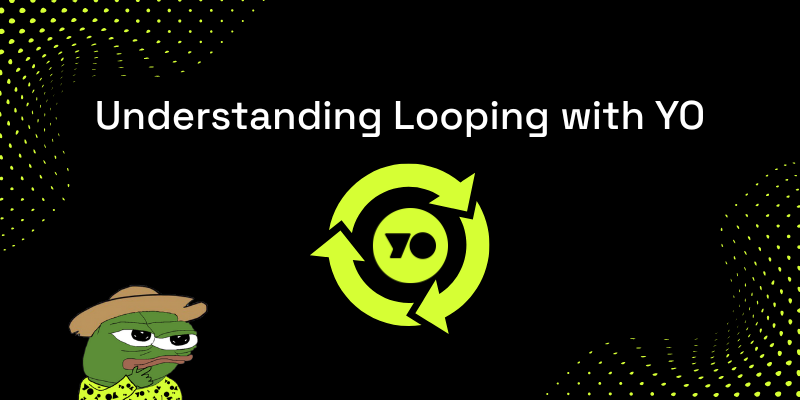- Exponential Edge
- Posts
- Looping in DeFi: How to boost your yield efficiently
Looping in DeFi: How to boost your yield efficiently
A beginner’s guide to one of the oldest and most powerful strategies in DeFi lending
Hey Edge readers,
This week we’re diving into one of the oldest but still most powerful strategies in DeFi: looping. Also known as recursive borrowing, looping has been around since MakerDAO’s early days and was a key driver during the 2020 yield farming boom. It remains a go-to move for users who want to squeeze more rewards out of yield protocols and airdrops. But while the rewards can multiply quickly, so can the risks. Let’s break it down.
Stay sharp. 🫡
-The Exponential team

What is looping?
Disclaimer: This content should not be taken as financial advice. Always do your own research before making any investment decisions.
Looping, sometimes called recursive borrowing, is a classic DeFi strategy that’s been around since the earliest lending markets. MakerDAO users were looping ETH back in 2017, and by 2020 it became mainstream during the $COMP farming boom. Today, it’s one of the most common ways DeFi users boost yield across Aave, Morpho, Euler, and beyond.
Here’s how the looping flow looks in practice:
You deposit an asset as collateral (yoUSD).
You borrow (USDC) against that collateral.
You use what you borrowed to mint more of the same yield token.
You deposit that again as collateral.
Repeat.
Each loop increases your position size and, with it, your yield and rewards. For YO vaults, it also multiplies your YO Points.
For example, say you deposit $100 into yoUSD. As a standard depositor, you earn 100 YO Points per day (1x Points per $1 deposited).
First loop: You borrow $90 (at 90% loan-to-value) and mint more yoTokens. Now your total deposit base is $190, so you’re earning 190 Points per day instead of 100.
Second loop: You borrow $81 against the $90 deposit, mint more, and redeposit. Your base grows to about $271, earning 271 Points per day.
Third loop: Borrow $73 more ($81 × 0.9), loop again, and your base rises to $344, earning 344 Points per day.
By the third loop, you’ve turned an initial $100 deposit into ~3.4x more YO Points, all without adding any additional capital. Sounds great, so what’s the catch?
The tradeoff is risk. Every time you loop, you’re pushing your loan-to-value (LTV) ratio closer to the liquidation threshold, the point at which your collateral can be liquidated to protect lenders against your outstanding loan. At some point the extra exposure isn’t worth the added risk or the cost of borrowing.
For example, suppose the liquidation threshold on a market is 90% LTV and your current position sits at 85% LTV. To calculate the buffer before your collateral is liquidated:
Buffer % = (Liquidation Threshold - LTV) / Liquidation Threshold
Buffer % = (90 - 85) / 90 = ~5.56%
That means the price of yoUSD needs to fall by about 5.5% before your position is at risk of liquidation. The higher you loop, the smaller this buffer becomes, which is why most farmers stop looping well before the maximum.
Today, you don’t have to loop manually. Protocols like Euler and Contango now automate the process so you can simply pick your target leverage and let the system handle the intermediate steps. Others like IPOR go further by fully managing the looping strategy for you, deciding how many loops to run and keeping your LTV within safe ranges. In short, looping is the DeFi-native way to scale yield efficiently.
Check out the latest blog for a full breakdown of DIY, assisted, and fully automated looping strategies with YO👇

TL;DR
The new and improved YO UI ✨
Treasure Chests are LIVE! 🪙
New Pendle yield & Contango looping markets for yoETH/yoUSD 🚨
YOligarchy Week 3 continues; $1k in prizes up for grabs. 🏆
New Contango, EarnBase, IPOR integrations. 🤝
Learn about looping through our latest explainer. 🧠
We want to hear from you! 🗳️What type of content would you like to see more of in Edge? Your feedback helps us create content that matters to you. |

In the news 🗞️
DeFi TVL rebounds to $170B. After three years of rebuilding from the Terra collapse, DeFi has fully erased its bear market losses, with Ethereum holding 59% of capital and newcomers like Base, HyperLiquid, and Sui collectively surpassing $10B. The recovery comes with more sustainable single-digit yields and rising institutional adoption, but $2.5B lost to hacks in 2025 highlights security remains one of DeFi’s biggest challenge.
Tether co-founder launches STBL for tokenized stablecoins. STBL introduces a ‘Stablecoin 2.0’ model that splits tokenized RWAs like money market funds into a freely usable dollar-pegged stablecoin (USST) and an interest-bearing NFT (YLD). Unlike USDT, where issuers keep the yield, STBL lets depositors retain returns, aiming to align with the GENIUS Act while maintaining compliance.
Ethereum DeFi activity shifts to L2s. While Ethereum mainnet fees fell 44% in August, Layer 2 networks like Arbitrum and Base are surging with $20B and $15B in TVL, along with hundreds of millions of transactions. Analysts say Ethereum is evolving into a secure settlement layer for institutional-grade assets, while L2s become the execution hubs for fast, low-cost DeFi strategies and innovation.
Trending 📈
|
|
Let us know how we did 👇Provide your feedback on today's issue of the Exponential Edge newsletter. (1 ⭐️ - not useful at all, 5 ⭐️ - extremely useful) |


